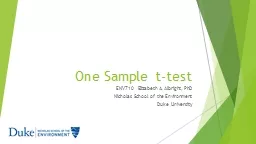

ENV710 Elizabeth A Albright PhD Nicholas School of the Environment Duke University General Steps in Conducting a Comparison of Means Test 1 Decide type of comparison of means test one sample two sample paired samples ID: 133793
Download Presentation The PPT/PDF document "One Sample t-test" is the property of its rightful owner. Permission is granted to download and print the materials on this web site for personal, non-commercial use only, and to display it on your personal computer provided you do not modify the materials and that you retain all copyright notices contained in the materials. By downloading content from our website, you accept the terms of this agreement.
Slide1
One Sample t-test
ENV710 Elizabeth A. Albright, PhDNicholas School of the EnvironmentDuke UniversitySlide2
General Steps in Conducting a Comparison of Means Test
1. Decide type of comparison of means test.
(one sample, two sample, paired samples)
2. Decide whether a one- or two-sided test.
3. Examine the appropriateness of a comparison of means test (based on the assumptions)***
4. Establish null and alternative hypotheses.
5. Decide whether a z-statistic or t-statistic is appropriate.Slide3
6. Calculate sample mean(s).
7. Calculate standard deviation of sample IF using a t-test.
8. Calculate standard error.
9. Calculate z-statistic or t-statistic.
10. Determine p-value from the test statistic using the appropriate z or t distribution. 11. Interpret the p-value in terms of the hypotheses established prior to the test.
General Steps in Conducting a Comparison of Means TestSlide4
One Sample t-test: Motivating Question
Do Duke MEM students walk
more than 10 miles a week on average?
One-sided test
Based on enrollment records, we
randomly select 30 full-time, campus-based MEM students and give each a pedometer. MEMs wear pedometer and return after a week.Establish hypotheses
Ho: µ
walking
≤ 10 milesHa: µwalking > 10 milesSlide5
Collect the Data
Miles
Observations
30
Mean
12.27
Standard Deviation
7.09
Minimum
2
Maximum
30
Miles Walked in One Week by MEM Students (n=30)Slide6
Assumptions
Independent observationsWe randomly selected MEM students to help ensure independence.Normally distributed
population of miles walked by MEM students
Histogram suggests that the population may be roughly normally distributed
This assumption becomes more problematic with outliers, heavy
skewness and a small sample size. Slide7
t-statisticSlide8
t-statistic
Slide9
t-statistic
Slide10
t-statistic
Slide11
t-statistic
Slide12
t-statistic
Slide13
t-statistic
t=1.75, 29 degrees of freedomp-value = 0.0903
Given that our null hypothesis
is true (that Durham residents
walk less or equal to than 10
miles/week on average), theprobability of getting theresults we got, or more extremei
s 0.09.Slide14
How strong is the evidence?
Ramsey and Schafer (2002). The Statistical Sleuth. A Course in Methods of Data Analysis, Second Edition, p. 47.
14Slide15
Conclusion
Mildly suggestive, but inconclusive, evidence that Durham residents, on average, walk more than 10 miles a week.